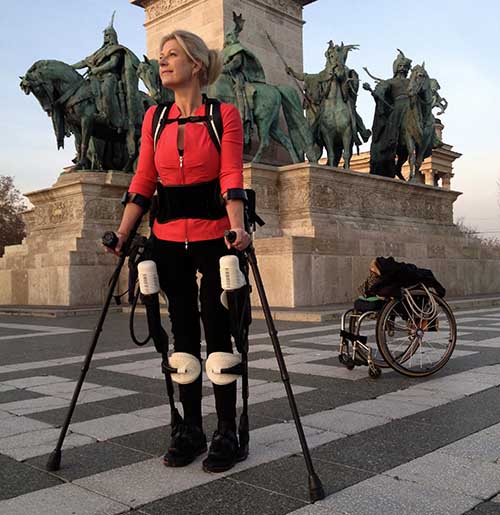3D Systems Creates Hybrid Robotic Exoskeleton For Paraplegics
3D Systems announced that it has collaborated with EksoBionics to build a 3D-printed hybrid exoskeleton robotic suit that ostensibly will allow users with paralysis of the lower extremities to walk upright.
A woman named Amanda Boxel was the test pilot for the suit (although this isn’t the first time she’s tested a prototype of this sort),and you can see in the photos that she indeed is standing up and taking steps without any third-party human assistance. Boxel has been paralyzed from the waist down ever since suffering a freak injury in a skiing accident 22 years ago. (Skip to about 1:30 in the video below to see Boxel walk.)
“After years of dreaming about it, I am deeply grateful and thrilled to be making history by walkingtall in the first ever 3D printed Ekso-Suit, made specifically for me,” she said. “This project represents the triumph of human creativity and technology that converged to restore my authentic functionality in a stunningly beautiful, fashionable and organic design.”

The suit’s designers used 3D scanning technology to capture the exact shapes of Boxel’s spine, thighs, and shins to create the digital model from which the parts of the suit could be created. “Sophisticated mechanical actuators and controls, manufactured and provided by Ekso Bionics, were then integrated with the more fluid components that were 3D printed from the customized scans to create the first ever bespoke suit,” reads a press release.

The suit
3D printing is great for creating toys, foodstuffs, and engineering prototypes, but sometimes we forget that the technology can also be used to help give mobility and strength to those who otherwise don’t have it.
A woman named Amanda Boxel was the test pilot for the suit (although this isn’t the first time she’s tested a prototype of this sort),and you can see in the photos that she indeed is standing up and taking steps without any third-party human assistance. Boxel has been paralyzed from the waist down ever since suffering a freak injury in a skiing accident 22 years ago. (Skip to about 1:30 in the video below to see Boxel walk.)
“After years of dreaming about it, I am deeply grateful and thrilled to be making history by walkingtall in the first ever 3D printed Ekso-Suit, made specifically for me,” she said. “This project represents the triumph of human creativity and technology that converged to restore my authentic functionality in a stunningly beautiful, fashionable and organic design.”

The suit’s designers used 3D scanning technology to capture the exact shapes of Boxel’s spine, thighs, and shins to create the digital model from which the parts of the suit could be created. “Sophisticated mechanical actuators and controls, manufactured and provided by Ekso Bionics, were then integrated with the more fluid components that were 3D printed from the customized scans to create the first ever bespoke suit,” reads a press release.

The suit
3D printing is great for creating toys, foodstuffs, and engineering prototypes, but sometimes we forget that the technology can also be used to help give mobility and strength to those who otherwise don’t have it.

